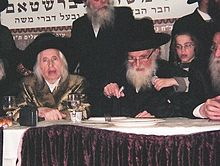Nigun
Israeli music |
|---|
| Religious |
| Secular |
|
| Israel |
| Dance |
|
| Music for holidays |
|
A nigun (Hebrew: ניגון meaning "tune" or "melody", plural nigunim) or niggun (plural niggunim) is a form of Jewish religious song or tune sung by groups. It is vocal music, often with repetitive sounds such as "Bim-Bim-Bam", "Lai-Lai-Lai", "Yai-Yai-Yai" or "Ai-Ai-Ai" instead of formal lyrics. Sometimes, Bible verses or quotes from other classical Jewish texts are sung repetitively to form a nigun. Some nigunim are sung as prayers of lament, while others may be joyous or victorious.[1][2]
Nigunim are largely
Hasidic nigunim

A revival of interest in
Some nigunim originate from non-Jewish sources. Hasidic Jews, based on a practice of their founder
Nigunim are usually sung at Hasidic gatherings (Tish/Farbrengens) when large numbers of followers come together to sing and to discuss spiritual concepts. The belief is that when you sing a nigun, the soul of the rabbi who created it appears in the room. On festive occasions the nigunim, especially, are joyful melodies. On the festival of Simchat Torah, the most joyous day in the calendar, fervent nigunim are sung in the dancing with the Torah scrolls in the synagogue.
Amongst the variety of
Kaliver nigunim

The Kaliver Dynasty began with Rabbi Yitzchak Isaac Taub (1744–1828) of
Forest, O forest, how vast are you!
Rose, O rose, how distant you are!
Were the forest not so vast,
My rose wouldn't be so far.
Who will guide me out of the forest,
And unite me with my rose?
Then he sang it as Rabbi Leib Sarah's heard it.
Exile, O exile, how vast are you!
Shechinah, Shechinah, how distant you are!
Were the exile not so vast,
The Shechinah wouldn't be so far.
Who will guide me out of the exile,
And unite me with the Shechinah?
Another famous song by the Kaliver Rebbe is Sírnak, rínak a bárányok – also in Hungarian.
Another example is Kol Haberuim by Baruch Levine, whose lyrics go:
There's a chamber that doesn't open,
but with a nigun...
Chabad nigunim
Nigunim of the
- Niggun Shamil[4]
- Niggun of Four Stanzas
- Tzomah Lecha Nafshi
- Hachanah Niggun
- Anim Zemirot
- Stav Ya Pitu
- Hu Elokeinu
Musar Movement Nigunim
The Musar movement has also made use of nigunim, based on the realization of how music affects the inner life. In the 19th century, the Musar movement developed its own distinctive nigun chanting traditions.[5] In the 21st century, nigunim may be used at the start and the end of musar study sessions[6] and may help to create an emotional musar experience.[7]
See also
Nigunim:
- Nachman of Breslov
- The Kaliver Rebbe
- Rebbe Moshe Zvi Giterman
Practices:
- Jewish meditation
- Dveikut
Citations
- ^ Haida Archived 1999-10-07 at the Wayback Machine Touchstone Sacred Dance Library, Accessed February 2014.
- ^ Music In Kaballah, The Nigun's Influence on the Soul From the book Shirat HaLev (The Song of the Heart) by Shmuel Stern – Translated by Gita Levi. Accessed February 2014.
- ^ "The Singing Tzaddik"
- ^ "Nigun Shamil: The Soul Endlessly Yearning for What It Has Always Never Been.
- ^ Muir, S. "Hasidism and Mitnagdism in the Russian Empire: the (mis)use of Jewish music in Polish-Lithuanian Russia" (PDF).
- ^ "Afternoons of Mussar". mussarinstitute.org. Archived from the original on 2019-05-29. Retrieved 2019-05-20.
- ISBN 9781620328750.
General and cited references
- Pinson, DovBer, Inner Rhythms: The Kabbalah of Music, Jason Aronson, Inc. 2000. Excellent chapters on the history of Jewish music, the various types and uses of Hasidic nigunim, etc.
- Stern, Shmuel, Shirat HaLev (Trans The Song of the Heart) Translated by Gita Levi.
External links
- CMusic - Lyrics & Reviews for Chasidus Music
- Spiritual Jewish music in Bandcamp
- Kabbalah of Music
- Shamil Nigun
- Napoleon's March
- Music in Kabbalah
- Biala Nigunim
- Modzitzer Nigunim
- The Nigun from an Ethnomusicological Perspective
- Listen to hundreds of Chabad Nigunim online
- Nigun, about Jewish music chabad.org
- Neohasid - Chasidus without borders
- Power of the Nigun
- Music of Baruch Levine


